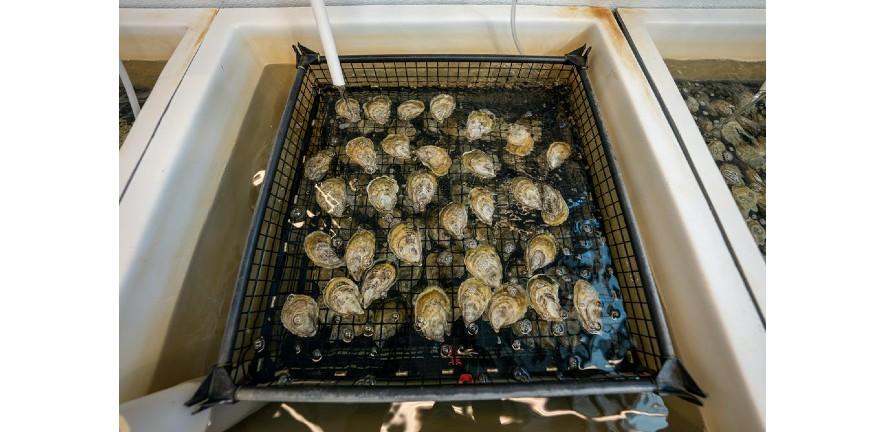
Submitted by K.L. Hlaba on Thu, 17/03/2022 - 16:34
With a current human population of 7.6 billion, and an expected growth to 9.8 billion by 2050, demands for nutrient-rich foods are increasing. Current estimations suggest that over 2 billion people world-wide suffer from a micronutrient deficiency (MND), which may increase with global population size unless current food practices change. This, in tandem with finite agricultural land that has been subjected to detrimental farming techniques for decades, has challenged previous food security practices to look towards farming sustainable and micronutrient rich foods from the ocean - also known as blue foods.
Current blue farming practices predominantly focus on the production of finfish, but an underappreciated blue food are bivalve molluscs (clams, mussels, oysters, etc.). Capable of producing high value by-products, being high in protein and micronutrients, and as shown by the Aldridge lab at the University of Cambridge, of being fortifiable with various vitamins, bivalves are a sustainable option that also provide additional important nutrients that include Omega 3, vitamins A & B12, iodine, calcium, iron, and zinc. Many of the aforementioned nutrients are the main factors missing in micronutrient deficient populations, thus securing bivalves’ place as a promising resource for delivering both food and economic security.
The considerable filter-feeding capacity of bivalves can create food safety concerns through their bioaccumulation of toxins and pathogens. Bivalves not only filter nutrients important for growth, but also accumulate viruses and bacteria from untreated sewage, heavy metals and pesticides from industrial and agricultural waste, and biotoxins from toxic algal blooms. These hazards are typically cleared by means of depuration; a process where bivalves are placed in clean water and treated with various combinations of chemicals and/or UV light to greatly reduce biological contaminants. However, these current methods do not reduce biotoxins, heavy metals, or pesticides that are stored in the tissues of the bivalve, and are not completely effective against viruses and bacteria. This means that even bivalves that have been through depuration processes remain dangerous to humans and result in low consumer trust, thus constraining the opportunities for bivalves to become a more mainstream component of sustainable global diets.
To mitigate risk to human health beyond growing in approved coastal areas and utilizing depuration methods, current seafood farming standards also require testing to ensure the aforementioned hazardous insults are below certain levels. However, this system is founded on sampling, and as such, contaminated bivalves still enter the market, albeit in lower numbers than if no testing was done. Tied to a lack of familiarity, and high production costs, these incidents have rightly caused concerns for food safety, resulting in the drive for bivalve aquaculture to lag behind other fisheries.
As saltwater bivalves are the predominant sourced bivalve, coastal regions are the primary location for farming, leaving landlocked communities and countries with an inability to tap into the food and nutritional security bivalves have to offer. Between the human health risks bivalves carry due to polluted water, as well as ocean acidification and temperatures continuing to increase, the coastal regions capable of producing the worlds marine bivalves are also at risk of failing. These challenges surrounding bivalve aquaculture have led to me, as a PhD student within David Aldridge’s group in the Department of Zoology, and Cambridge’s Conservation Initiative, to begin looking at ways of leveraging emerging technologies in bivalve aquaculture production from the Aquatic Ecology Group. This work will help to develop a closed system that can allow urban settings, including currently untapped landlocked areas, to produce safe, fast-growing, and sustainable bivalve products.
Growing bivalves for consumption on-shore would allow for more rigorous monitoring of livestock compared to the current conventional manner of farming in the open ocean. Being able to use artificial seawater would also mean that biotoxins would no longer be a need for concern, and the saltwater used would be regularly tested for any pathogens or heavy metals to ensure purity of livestock. Growing in controlled environments would lend a hand in optimizing growth, helping to meet the increase in global food demands for nutrient rich and available food sources.
The development and implementation of a closed system to farm saltwater bivalves on-shore in urban environments would not only mean a secure source of highly nutritious food for coastal regions, but it would also allow for the expansion and integration of such blue foods into landlocked territories where fresh sources of bivalves currently do not exist. Even more, this novel farming system would require facilities that would also come with the creation of jobs, which tied with the production of livestock, would lend itself to supporting economic security. Ultimately, as urban aquaculture of bivalves does not currently exist, this work is aimed at demonstrating its viability and its potential to disrupt the current aquaculture methods and contribute to the ways that urban environments can address food, nutritional, and economic security in the future.
If you are interested in collaborating or learning more, please contact Broderick House via email.
Written by Broderick House.
Image provided by Broderick House.
References:
1. Douglas P, Robertson S, Gay R, Hansell AL, Gant TW. A systematic review of the public health risks of bioaerosols from intensive farming. International Journal of Hygiene and Environmental Health. 2018;221(2). doi:10.1016/j.ijheh.2017.10.019
2. Golden CD, Koehn JZ, Shepon A, et al. Aquatic foods to nourish nations. Nature. 2021;598(7880). doi:10.1038/s41586-021-03917-1
3. Willer DF, Aldridge DC. Sustainable bivalve farming can deliver food security in the tropics. Nature Food. 2020;1. doi:10.1038/s43016-020-0116-8
4. Willer, D., Nicholls, R. and Aldridge, D. Opportunities and challenges for upscaled global bivalve seafood production. Nature Food. 2021. doi: 10.1038/ s43016-021-00423-5

